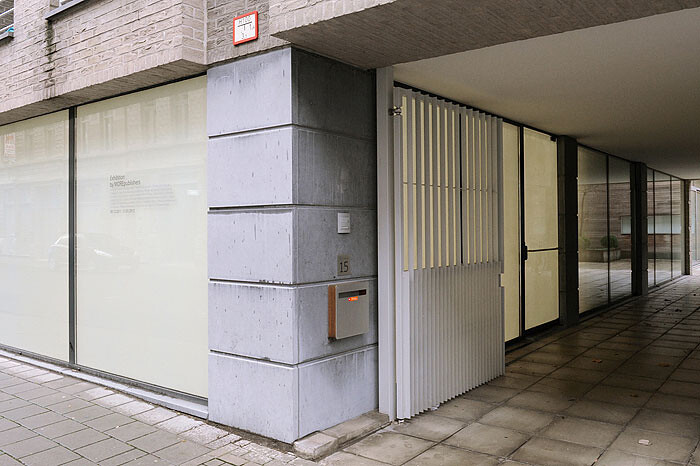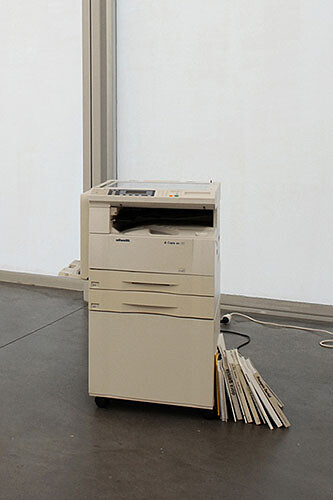Mirroring a range of ephemera and printed matter on the periphery of exhibition making, publishing, and artistic practices, Brussels-based MOREpublishers have presented the group show “EXHIBITION” to reflect on their own activities of commissioning artist editions. By employing a syntax of framing and formatting, “EXHIBITION” plays on both the notion of an exhibition and that of a publishing house as an image by fragmenting and de-centralizing the various elements and components of printing, and presenting specific works that animate an otherwise static visual culture.
At the center of “EXHIBITION” is a conversation: in lieu of a press release, the edited transcript between artist Michael Van Den Abeele and MOREpublishers, Butlers for Butlers, serves to breakdown the hierarchy between “servers.” It also serves as an allegory for institutional procedures: how image and text, exhibition and publication, presentation and documentation can potentially (or not) serve each other in a self-contained, self-referential system. Oscillating between authorship and readership, producer and consumer, labor and leisure, the individual works of the show construct a form of architecture (a Château, a master) that overshadows the circulation of material as a server to images.
For instance, Richard Venlet has painted the windows of the gallery to delineate its perimeters and, likewise, to obscure the interior and exterior views. Emitting the glow of subdued light source, like an advertising light-box, the “showroom aesthetics” have been rendered as a backdrop of opaque white emptiness. Originally presented in 1997 as a documentary photograph in the Belgian arts newspaper De Witte Raaf, (The White Raven), the “new” version of this work employs the same formal procedure while referring to its own history; but this time Venlet used only the cover of the 1997 magazine as the “documentary” insert, distributing its past and current existence as both original and reproduction. Along the same lines of thought, Peter Lemmens’s […] And Annotated, For Example […] (xeroxed edit) (2011) alters the photocopier’s inherent objectivity. The copy bed is an engraved glass template that frames the re-production of the other artists’ catalogues as customized editions. It’s an automatic-edition-making-machine through the push of the “copy” button, and a self-serving instrument that simultaneously creates and destroys originality and authorship.
Willem Oorebeek’s dot-screen-wall (2008) renders a blow-up of the ubiquitous dot as the primary element of mechanical printing. Following the logic of photographic enlargement, these dots are arranged as a wallpaper pattern to frame a blank cinema screen, subjecting cinematic experience to the language of interior decoration. Relying solely on the descriptive functions of the spoken word, Lieven de Boeck’s vinyl LP Let’s go upstairs then… (2011) is a recording of the supplementary audio tour of a previous exhibition. As a documentation of Boeck’s artworks in their relation to physical architecture, visual references are bypassed through this purely auditory account. The system of visual directions used in bookmaking (crop marks, color bars, registration lines) are rendered semi-abstract in the collaborative overprint The Printer, May 27th, 2003 (2003), by Sylvie Eyberg & Valérie Mannaerts, Thierry de Duve, and Saskia Gevaert, in which the excess of ink incurred during a printer error becomes a pictorial and textual bleed in the production of their artists’ catalogue. The intended clarity of representational documentation is re-configured here through arbitrary collage.
Throughout the visible and reductive renderings of ephemera-based material here, simulation is at the core: Steve van den Bosch’s … (no date), a digitally projected image of a blank “certificate of authenticity of the artwork”; Pernille Kapper Williams’s Brussels 2011/2012 (2011), a framed announcement for a year-long exhibition “by invitation only,” yet with no physical address to go to; or Mark Luyten’s Cinéma (1995 -2004) (2011) poster advertising “Now Showing” and “Running Continuously” all serve to self-contain a time-lapse of idiosyncratic thought process.
The announcement card to “EXHIBITION”: “You got some work done today?” “Research!” documents a handwritten note-passing correspondence between the artists Nico Dockx and Joseph Grigely. Implying the imbalance between labor and leisure yet generating an economy of exchange, a compromise has been made in the silent negotiation here. It’s a work that’s exemplary of the whole, of how the exhibition makes the absence and presence of various procedures, the printed matter, and the exhibition itself serve each other in a dialogue of continuous flux.







